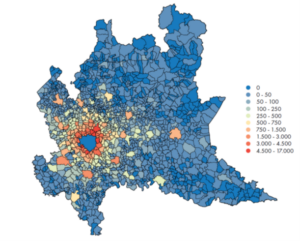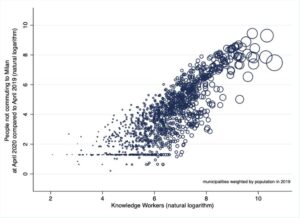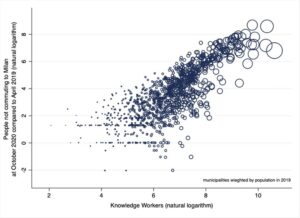The Covid-19 pandemic has rapidly altered the habits and lifestyle of worldwide populations and will have effects in the medium-long run. The need for «social distancing» has encouraged a reschedule of the working methods. It was evident in the service industry, where remote working- including teleworking and home-working – achieved the limelight.

Background from existing literature
The literature has underlined that remote workers are mainly knowledge workers; they are more willing to be highly educated, full-time, permanent, and high-income workers. Besides, a little more than men, women started working from home in 2020, especially in cities and suburban areas.
During the Covid-19 pandemic, several studies have focused on the rise of remote working. The need for social distancing and the chance for knowledge workers to work remotely, thus reducing the commuting trips towards the large urban agglomerations, has made suburban (and peripheral) areas more attractive places to live and work. Nevertheless, other studies argue to what extent the “leave from the big cities” will be a short, medium, or long-term phenomenon, and contextually the effects on the suburban and peripheral areas are questioned.
The consequences of the pandemic spread in Lombardy and Milan
Within this context, the Small Grant Scheme on Pandemics, Cities, Regions & Industry titled “The growth of remote working during the Covid-19 pandemic and the renewed role of coworking spaces in peripheral areas” aimed at exploring the attractiveness of the municipalities outside the city of Milan in Lombardy region (north-west of Italy) towards remote workers during the Covid-19 pandemic. The research belongs to the broader research project Cost Action CA18214 “New working spaces and impact on the periphery” of which Ilaria Mariotti is Chair and Grant Holder Scientific Representative, and Dante Di Matteo member of the Italian Team.
To reach this goal, TIM mobile data are used to monitor the human presence in the city of Milan during the first waves of the pandemic (April 2020 and October 2020), compared to the period before the pandemic (April 2019). These people before the pandemic used to commute to Milan, while during the pandemic have drastically reduced their presence in the city. The phenomenon of the “leave” from Milan is described through georeferenced maps, showing which municipalities in the Lombardy region attracted a higher share of people previously commuting to Milan.
Population shifts and correlations to knowledge workers
Figure 1 shows the difference between April 2020 and April 2019 in the human presence inflows into the city of Milan. It emerges that the suburban municipalities (in red and orange) had gained more people (from 17,000-4,500 to 4,500-3,000), who, before the pandemic (April 2019), were used to commute to Milan. Exceptions occur in the cases of the capital provinces of Bergamo, Brescia, Lodi, and Pavia, which are farther from Milan. Instead, the municipalities that have gained less or even lost some presences are coloured in blue. The more attractive municipalities are where their residents probably worked from home during the first wave.

Figure 1 – Difference of the human presence inflows (number of people) into the municipality of Milan between April 2020 and April 2019. Source: authors’ elaboration on «Tim Big Data – Data Visual Insight».
Figure 2a shows the correlation of the difference of the human presence inflows into the city of Milan (on the vertical axis) between April 2020 – and April 2019 and the number of knowledge workers living in the municipalities (on the horizontal axis). Figure 2b shows the correlation between October 2020 and April 2019. The municipalities are weighted according to the population in 2019, and data are expressed in natural logarithm. A positive correlation emerges in both periods, thus confirming that municipalities with a higher concentration of knowledge workers are more willing to host remote workers during the pandemic.

Figure 2a – Correlation between the change of the human presence inflows in Milan between April 2020 and April 2019 and the number of knowledge workers living in the municipalities in Lombardy. Source: authors’ elaboration on «Tim Big Data – Data Visual Insight» and ISTAT data.

Figure 2b – Correlation between the change of the human presence inflows in Milan between October 2020 and April 2019 and the number of knowledge workers living in the municipalities in Lombardy. Source: authors’ elaboration on «Tim Big Data – Data Visual Insight» and ISTAT data.
Co-working spaces and work/life balance?
An econometric analysis (ordinary least squares model – OLS) corroborates the findings of the descriptive statistics, by exploring the determinants of the attractiveness of the municipalities outside the city of Milan. The municipalities closer to Milan, with a strong broadband connection and a high concentration of knowledge workers and foreign immigrants, are more willing to host remote workers.
Within this context, it is discussed whether and how co-working spaces might represent a good alternative for home workers looking for a better place to work, allowing them to balance work and life and/or reduce the sense of isolation.

Prof. Ilaria Mariotti (Twitter @ilariamariotti5; Website) is Associate Professor of Urban and Regional Economics at DAStU, Politecnico di Milano (IT). Her research interest concerns firm location and relocation, logistics and innovation, new working spaces, and the effects on the users’ economic performance and well-being and the local context. She is Chair and Grant Holder Scientific Representative of the Cost Action CA18214 (2019-2023), Project Coordinator for the Politecnico di Milano research team of the CORAL Project, Horizon 2020 – Marie Curie -ITN-2020 (2021-2024), and associate fellow at c.MET05, National University Centre for Applied Economic Studies (Ferrara, IT).

Dante Di Matteo (Twitter @dantedimatteo_; Website) is research fellow of applied economics at DAStU, Politecnico di Milano (IT) and associate fellow at c.MET05, National University Centre for Applied Economic Studies (Ferrara, IT). His main research interest focus on regional and transport economics, tourism studies, place-based policies for local development, and electoral dynamics.

Federica Rossi, Ph.D. in Economics, is a postdoctoral research fellow in Economics at Politecnico di Milano – DAStU, and adjunct professor at Università degli Studi di Milano. Her research interests include topics in transport and regional economics, such as firms’ location and relocation choices, remote working, high-speed railway projects and accessibility.
Are you currently involved with regional research, policy, and development? The Regional Studies Association is accepting articles for their online blog. For more information, contact the Blog Editor at rsablog@regionalstudies.org.